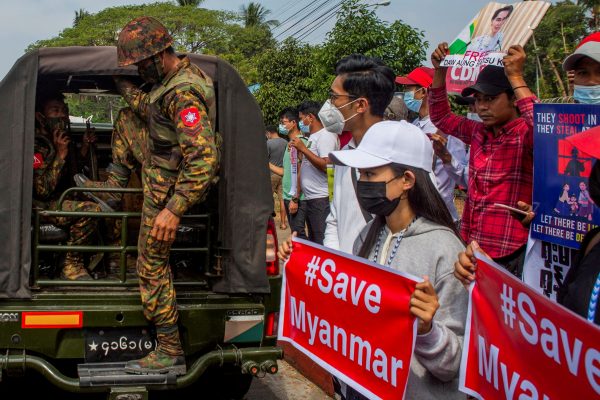India’s cautious response to the military coup in Myanmar contrasts its previous policies. The primary motive behind India’s shift is to balance China’s influence and to contain insurgencies along the Indo-Myanmar border.
India and Myanmar were initially close allies since the latter gained independence in 1948. But following the Myanmar military coup in 1962, the countries maintained a relationship characterised by stagnancy for the next two decades. The governments of Indira Gandhi and Rajiv Gandhi viewed military rule in Myanmar as a threat to global democratic values.
In 1988, following a crackdown by the Myanmar Armed Forces (Tatmadaw), India aligned itself firmly with pro-democracy camps. It fiercely criticised the junta, provided material support to democracy activists in Yangon, set up refugee camps in regions with political activists, such as Manipur and Mizoram, and allowed them to express their views openly. Considering this, New Delhi’s current approach seems puzzling. New Delhi has expressed concern over the ‘political turmoil’ in Myanmar but it has neither commented on the coup itself nor publicly acknowledged the 2020 election results.
In the 1990s, India’s Look East Policy, now at times referred to as the Act East Policy, shifted India’s foreign policy from Nehruvian idealism to realism. Wanting to avoid isolation from the military regime that had taken hold of Myanmar, India’s foreign policy towards Myanmar switched from pro-democracy to pro-military, subsequently diminishing the support for the democracy movement.
Although the Look East Policy aims to integrate East and Southeast Asian nations to boost India’s interests, Myanmar serves a marginal role. The policy enabled warmer relations between India and Myanmar’s military junta as New Delhi was willingness to engage with the Tatmadaw to counter China’s influence and to contain insurgent groups in north-eastern India. The Indian government, under the Bharatiya Janata Party-led National Democratic Alliance in the late 1990s, realised that the military would remain a significant power in Myanmar. The government shifted its approach to align with ‘whoever worked in India’s interests’.
India openly made its stance clear in 2006 when the then External Affairs Minister Pranab Mukherjee explained that India could not spread democracy to neighbouring countries and that India had to deal with other governments as they exist. New Delhi placed security and political considerations ahead of democratic values, a practice that continues to this day.
In the wake of the 2021 coup, and in contrast to 1988, New Delhi signalled that Myanmar nationals fleeing into India are not welcome. The country has sealed its borders to prevent refugees from entering despite the unfolding bloodshed in Myanmar. India was among eight countries that attended a military parade in Myanmar’s capital Naypyidaw on 27 March 2021 to mark Tatmadaw Day which came less than two months after the Myanmar military’s coup. Besides attending military parades, the Modi government has also sold military weapons to Myanmar since the coup.
India, concerned over China’s influence, does not want to disturb its military ties with Naypyidaw and wants to contain the north-eastern rebel groups operating from Myanmar, a feat that is impossible without cooperation with the Tatmadaw.
India believes that China’s growing influence in Myanmar threatens states in Northeast India. These states have been a serious concern for New Delhi since the late 1980s. India accuses China of helping with military training and providing arms to insurgents in Northeast India, whose bases are located in Myanmar’s jungles. Despite its intention to contain insurgent groups on the Indo-Myanmar border, the Myanmar government is unable to take major military action against a substantial number of tribal insurgents due to its limited capacity.
There are roughly 2000 cadres of Indian insurgent groups with camps and training facilities active in Northeast India and Myanmar. A recent attack on Indian security forces that killed the family of a commanding officer as well as four other security personnel showed that Myanmar lacks the intent and the ability to counter these insurgents.
India should re-examine whether its realist approach to Myanmar is likely to bear the desired fruits. India’s best approach is to support a stable, democratic and pluralistic society. Myanmar’s nationwide protesters need India, as a democratic regional power, to get Myanmar back on the path to democracy. In the long run, building a strong relationship might serve India well. The Tatmadaw’s inability and unwillingness to find a response to India’s concerns means that India would be losing relatively little by endorsing the democratically elected leaders of the country.
Myo Min is a junior researcher at the Yangon School of Political Science.

